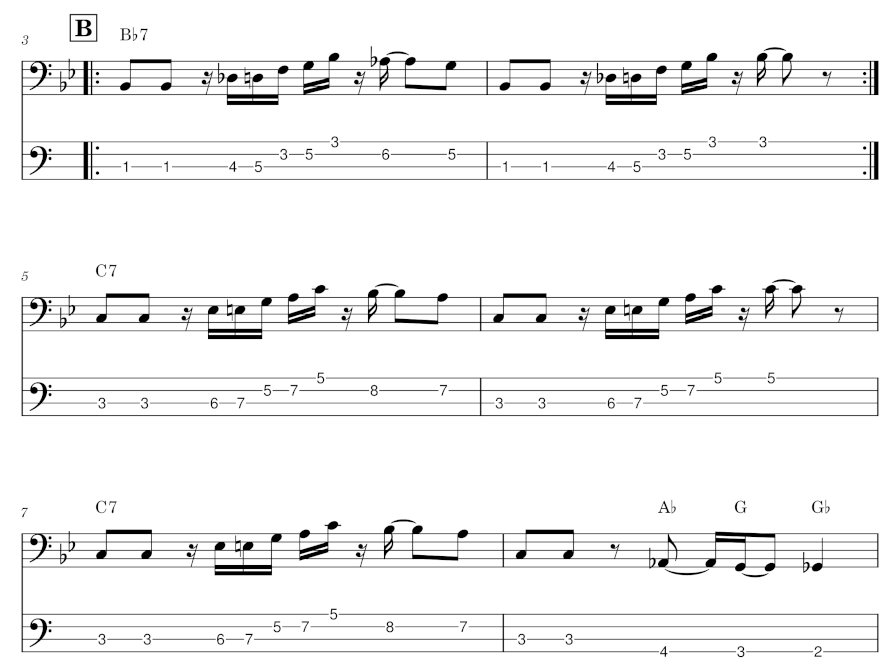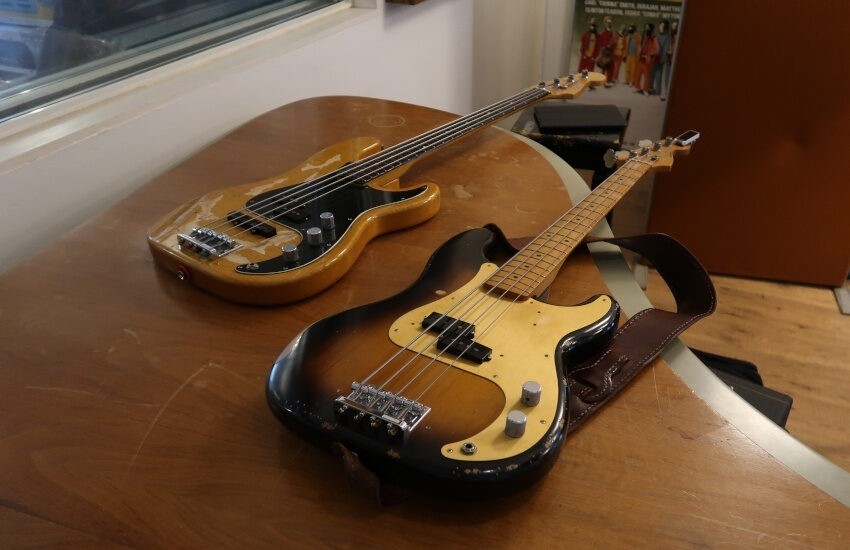This series focuses on expanding your bass guitar vocabulary by showing you different bass lines in real life situations. Write better bass lines today! Every groove has a transcription and an explanation why the bass line works with the harmony and the drums. This will surely power boost your bass line creativity!
Expanding your vocabulary and knowing why and where a certain bass lines works, will help you write better bass lines. And as we all know, writing your own bass lines is one of the most important skills as a bass player. Lets hop into it!
The groove
I had some help from my dear friend Tom Veltien on guitar on this one. As you can hear he is an incredible guitar player and a very musical guy. Check him out on Instagram.
Harmony: The chord progression
The bassline revolves around a very simple chord progression, that is much like a blues. In the beginning we start off on a groove in F7. Then we kick into the B-section, (where the solo starts). The organ is playing two chords here, which are a Bb and a C. In my bassline I add a dominant 7 for both chords, so we get a Bb7 and a C7 chord. If you have read my lesson about the modes, you probably know that if you see a dominant 7 chord, you can play the Mixolydian mode on it. If you haven’t, check it out by clicking here!
The youtube clip ends with a pentatonic riff that Tom and I play in unison. It doesn’t really serve a purpose, but it sure is a fun way to end a short video like this
Why the bassline works

So breaking down what you just heard, we start at the A-section of the song. Although the first chord is an F7, which has an A in it (the third of chord), we start of on an Ab. Seems weird, but it works great because we resolve to the third (A) of the chord and then to the root (F) soon after. It is very common to play a minor third over a dominant chord, it adds some nice tension to the sound.
The rest of the notes are all derived from the Mixolydian mode. I did add in a B, which is not in the scale (on the 4th downbeat of the second bar). This is simply a passing tone. If we use a note that is not in the scale but resolve it to a note that is in the scale, it can definitely sound cool! Notice how the kick drum and the bass line work together.
Using a concept: If it works don’t fix it

In the B-section I use the same trick on the Bb7 and the C7 chords: I use the minor third and the major third. The rest of the notes are again derived from the Bb Mixolydian mode and the C Mixolydian mode. Notice how the first two beats of every bar are in unison with the kick drum, giving it a heavy and beafy feel. Also notice how the high notes at the end of each bar interact with the accented hi-hats.
Pentatonic riff, going out with a bang

In the closing riff we play this riff that is based around an F minor pentatonic. By stopping the drums, the listener is drawn in even more! If you don’t know about pentatonics, be sure to check out my lesson on the subject. You can play this riff over an F minor chord, but in situations like this also over an F dominant chord. Try to transpose the riff to different keys to get the most out of it.
If you want to download the whole transcription as a pdf, you can click here.
Be sure to check out the rest of the free series via:
https://bassessentials.com/category/free-bass-lessons-online/how-to-write-basslines-groove-backpack/
Subscribe for new grooves
Do you enjoy Groove Backpack? You can subscribe using the form below to get notifications as soon as new grooves are available.
I hope you found this article helpful! Let me know in the comments what your thoughts are and if you have any questions or suggestions.

